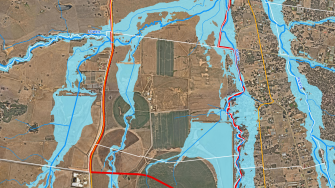
Project Aim (and/or Objectives)
The project deals with the optimisation of the climatic and microclimatic conditions in four future precincts in the South Creek of Sydney. The future precincts are: Combined Bringelly Town Centre and Rossemore, St Mary’s, Elisabeth Drive and Marylands. This study has challenged conventional thinking around mitigating urban heat, including the way we look at the Climatic Conditions in the Southern Creek area, energy impacts, impact on Electricity Demand, and heat Related Mortality.
The main objectives of the study are:
- To investigate the future climatic and microclimatic conditions in the South Creek area of Sydney and calculate their exact characteristics.
- To propose and evaluate mitigation and adaptation techniques and technologies to improve the outdoor and indoor ambient environment and quantify the potential for climatic improvements.
- To propose appropriate adaptation and mitigation technologies to decrease the energy consumption of buildings and quantify their impact.
- To propose mitigation techniques aiming to decrease the peak electricity demand and quantify the savings potential, and
- To propose mitigation techniques to reduce heat related mortality and quantify the potential health impact.
Method
Multiple measurement techniques and advanced simulation techniques have been used to satisfy the above described objectives. Several mitigation techniques including the use of additional greenery, evaporation, reflective materials and combination of the above are simulated to assess their mitigation potential.
Project outcomes
The results and conclusion have shown that:
- Because of the intense climatic change, the ambient temperature in Sydney by 2050 will increase by several degrees. The expected average increase is close to 4 °C.
- Additional construction and increase of the density in western Sydney by 2050 will further increase the ambient temperature, by 1-2 °C.
- Under the 2050 climatic conditions and the new land use and with 670000 non-irrigated trees planted in the area, the Peak Maximum Temperature in the South Creek during a very warm day will vary between 36 - 41 °C, with an average ambient temperature close to 38 °C. This means that although the increase of the density in the area, the plantation of such a very high number of trees in this urban zone may decrease the peak annual temperature between 1 to 2 °C.
- Under the 2050 climatic conditions and land use, Sc 3a, planting of 670 K trees in the Southern Creek, result in an increase of the Cooling Degree Days between 144 – 248 % compared to 2016-2017.
- The implementation of advanced mitigation technologies for the whole Sydney area can reduce the peak ambient temperature in Western Sydney up to 3 °C, compensate the impact of the additional urbanization and part of the impact of climate change.
- The impact of temperature increase cause by the climatic change and additional urbanization on the energy consumption of buildings is tremendous and may double or even triple the actual energy consumption of buildings in the whole Sydney area. In parallel, it may increase heat related mortality by about 25 %.
- The use of global climate mitigation techniques may decrease the projected increase of the cooling demand of buildings in 2050 up to 37% and reduce the projected heat related mortality by 25 %.
- The application of adaptation, energy conservation techniques in buildings in 2050, may decrease the cooling load of reference buildings up to 89 % and reduce the corresponding heating load by 50 % compared to Scenario 2 (This scenario is based on the 2018 land use and the 2050 climatic conditions).
- The magnitude of the expected climate change in Sydney is so high that just the application of mitigation techniques cannot counterbalance the expected impact on energy and heat related mortality. Adaptation techniques in combination with mitigation technologies have to be immediately implemented to protect the population by the expected temperature increase.
Project participants
Project Leader: Scientia Prof Mattheos Santamouris
Research team: Dr Riccardo Paolini, Dr Shamila Haddad, Samira Garshasbi
Contact person
Prof Mattheos Santamouris, m.santamouris@unsw.edu.au
